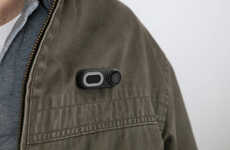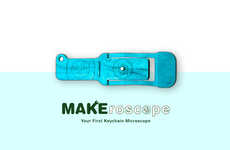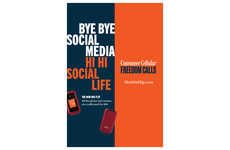
Make a Feature Film on Your Cell Phone
Nigel Goodwin — June 16, 2006 — Tech
References: news.yahoo
This is cool -- now anyone can make a feature film using only a cell phone.
It is increasingly common for video footage shot on cell phones to appear in the mainstream news media. This is largely due to the fact that camera phones are now ubiquitous, so when something happens, someone nearby can capture it on video.
But now, for the first, a camera phone has been used to shoot a feature-length documentary.
Italian filmmakers used a Nokia N90 to produce a 93-minute piece on love and relationships, entitled "New Love Meetings". The film consists of interviews with approximately 100 people the filmmakers met in bars, in markets and on the street.
No post-production manipulation was made to the footage. No professional lighting was used, but a pocket flashlight was occassionaly brought into service.
Given the technology's limitations, the film mainly features close-ups. But given that the film is a documentary about personal topics, the filmmakers say the use of a simple phone camera created a more personal atmosphere and allowed the interview subjects to open up more.
"To use a small instrument that belongs to people's daily routine allows you to establish an intimate dialogue, instead of using a regular camera," said co-director Barbara Seghezzi. "The interview becomes more like a chat."
The choice of technology also gave the filmmakers more flexibility and kept their costs at rock-bottom. The entire project cost only a few thousand dollars, including the filmmakers' hotel and accommodation costs.
The camera stored about 1 hour of footage. Footage was transferred to a computer once every two days.
"With the widespread availability of cell phones equipped with cameras, anybody could do this," documentary co-director Marcello Mencarini said in a telephone interview from Milan. "If you want to say something nowadays, thanks to the new media, you can."
It is increasingly common for video footage shot on cell phones to appear in the mainstream news media. This is largely due to the fact that camera phones are now ubiquitous, so when something happens, someone nearby can capture it on video.
But now, for the first, a camera phone has been used to shoot a feature-length documentary.
Italian filmmakers used a Nokia N90 to produce a 93-minute piece on love and relationships, entitled "New Love Meetings". The film consists of interviews with approximately 100 people the filmmakers met in bars, in markets and on the street.
No post-production manipulation was made to the footage. No professional lighting was used, but a pocket flashlight was occassionaly brought into service.
Given the technology's limitations, the film mainly features close-ups. But given that the film is a documentary about personal topics, the filmmakers say the use of a simple phone camera created a more personal atmosphere and allowed the interview subjects to open up more.
"To use a small instrument that belongs to people's daily routine allows you to establish an intimate dialogue, instead of using a regular camera," said co-director Barbara Seghezzi. "The interview becomes more like a chat."
The choice of technology also gave the filmmakers more flexibility and kept their costs at rock-bottom. The entire project cost only a few thousand dollars, including the filmmakers' hotel and accommodation costs.
The camera stored about 1 hour of footage. Footage was transferred to a computer once every two days.
"With the widespread availability of cell phones equipped with cameras, anybody could do this," documentary co-director Marcello Mencarini said in a telephone interview from Milan. "If you want to say something nowadays, thanks to the new media, you can."
Trend Themes
1. Cell Phone Film Production - Opportunity for filmmakers to create feature-length films using cell phone cameras, resulting in lower production costs and a more intimate atmosphere.
2. Mobile Journalism - Increase in the use of cell phone footage in mainstream news media, allowing for the rapid capture and dissemination of breaking news events.
3. DIY Documentary Making - Rise in individuals using cell phone cameras to create documentaries, providing a low-cost and accessible platform for personal storytelling.
Industry Implications
1. Film Production - Cell phone film production disrupts the traditional film industry by offering a cost-effective alternative for creating feature-length films.
2. Journalism - Mobile journalism disrupts the traditional news industry by enabling citizen journalists to capture and share real-time footage of important events.
3. Documentary Filmmaking - DIY documentary making disrupts the traditional documentary industry by empowering individuals to share their unique perspectives and stories using cell phone cameras.
4.4
Score
Popularity
Activity
Freshness























